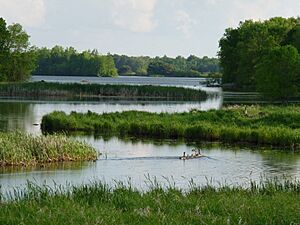Yellow River (Chippewa River tributary) facts for kids
The Yellow River is a cool waterway located in north-central Wisconsin. It's like a smaller stream that flows into a bigger one, which is called the Chippewa River. Most of the time, this river has a bottom made of mud and rocks, and it winds its way through thick forests and open farmlands. Did you know there are actually four different rivers in Wisconsin named Yellow River? This article is about the one that joins the Chippewa River!
Contents
Where Does the Yellow River Start and Go?
This Yellow River begins its journey in a special area near Perkinstown. It starts from two lakes, Matt Ochs Lake and Perch Lake, which are found in the township of Molitor. This whole area is part of the huge Chequamegon National Forest.
How the Landscape Was Formed
The land where the river starts is quite interesting! It's what scientists call a "terminal moraine". Imagine a giant, slow-moving river of ice, known as a glacier. About 18,000 years ago, a huge glacier reached this spot and then started to melt and shrink. As it melted, it left behind all the rocks, dirt, and sand it had pushed along. This pile of leftover material formed the hills and valleys you see there today, creating many small lakes and swampy areas.
Dams and Reservoirs
After flowing a short distance, the Yellow River forms a larger body of water called Chequamegon Waters Flowage. People who live nearby often call it Miller Dam. This is a man-made lake created by a dam. Further downstream, there's another dam near the town of Cadott, which also creates a small lake. Finally, the Yellow River flows into the Chippewa River when it reaches Lake Wissota at a spot called Moon Bay.
Undeveloped Areas
A lot of the Yellow River, especially the parts in the Chequamegon Forest, is still wild and untouched. You won't see many buildings or signs of people there. The only towns located right along the river are Gilman and Cadott.
A Look Back in Time: The Yellow River's History
The Yellow River has a long history, especially when it comes to trade and logging.
Early Trading Posts
Around the year 1787, a person named Michel Cadotte set up a trading post on the lower part of the Yellow River. This trading post was located right where the town of Cadott is today. Trading posts were important places where people could exchange goods, like furs for tools or supplies.
Logging and River Use
By 1861, people started to cut down trees (this is called logging) in the upper areas of the Yellow River. To help move the cut logs downstream, they built special dams called "log-driving dams." These dams would hold back water, and then release it in a rush to help float the logs down the river.
By 1880, a "winter road" was built that followed the river all the way up to a place called Westboro. This was a "tote road," which logging companies used to bring supplies to their workers who were cutting trees further upstream.
A Lumberman's Story
Bruno Vinette, who was an early lumberman, once shared an exciting story about riding a "crib" (a raft of logs) down the Yellow River during a flood:
I remember once when the water was very high, Gilbert and Company, on the Yellow River, needed just one crib to complete a raft and offered me twenty-five dollars to bring it down. I rigged up a couple of oars and started down alone. A lot of people stood on the bank watching to see what would happen. Instead of giving me any trouble, the crib floated like a cork. I did not have to touch the oars, and in a few minutes was safe below the falls.
This story shows how powerful the river could be and how skilled these lumbermen were!
Fun Things to Do: Recreation on the Yellow River
The Yellow River is a great place for outdoor activities, especially fishing and watching wildlife.
Fishing Adventures
Many people think the fishing in this river is some of the best around! The top spot for fishing is Chequamegon Waters, also known as Miller Dam Flowage. Here, you can catch different kinds of fish like bluegills, crappies, largemouth bass, northern pike, perch, and sometimes even walleye and smallmouth bass. In the river itself, the most common fish you'll find are northern pike and suckers.
Amazing Wildlife
The area around the Yellow River is full of incredible animals! You might spot deer, black bears, wolves, bobcats, coyotes, ruffed grouse (a type of bird), beavers, otters, muskrats, mink, raccoons, turkeys, and many different kinds of waterfowl (birds that live near water). It's a true wildlife paradise!


